#the Bridegroom
Photo


Ninth house by Leigh Bardugo
Blessed with Knowledge and Horror in an unreliable narrator
811 notes
·
View notes
Text
I hope 'The Bridegroom' found some semblance of peace after the events of 'Ninth House' because nobody else did.
18 notes
·
View notes
Text
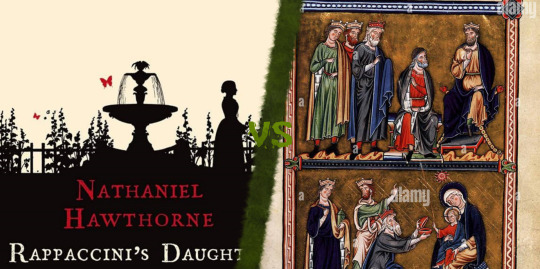
Rappaccini's Daughter (Nathaniel Hawthorne)
"Giovanni Guasconti, a young student renting a room in Padua, has a view from his quarters of a beautiful garden. Here, he looks at Beatrice, the beautiful daughter of Dr. Giacomo Rappaccini, a botanist who works in isolation. Beatrice is confined to the lush and locked gardens, which are filled with exotic poisonous plants grown by her father. Having fallen in love, Giovanni enters the garden and secretly meets with Beatrice a number of times, while ignoring his mentor, Professor Pietro Baglioni. Professor Baglioni is a rival of Dr. Rappaccini and he warns Giovanni that Rappaccini is devious and that he and his work (which involves using poison as medicine) should be avoided.
Giovanni notices Beatrice's strangely intimate relationship with the plants as well as the withering of fresh regular flowers and the death of an insect when exposed to her skin or breath. On one occasion, Beatrice embraces a plant in a way that she seems part of the plant itself; then she talks to the plant, "Give me thy breath, my sister, for I am faint with common air."
Giovanni eventually realizes that Beatrice, having been raised in the presence of poison, has developed an immunity to it and has become poisonous herself. A gentle touch of her hand leaves a purple print on his wrist. Beatrice urges Giovanni to look past her poisonous exterior and see her pure and innocent essence, creating great feelings of doubt and confusion in Giovanni.
In the end, Giovanni becomes poisonous himself: insects die when they come into contact with his breath. Giovanni is troubled by this, which he sees as a curse, and he blames Beatrice. Professor Baglioni gives him an antidote to cure Beatrice and free her from her father's cruel experiment. However, when Beatrice drinks the antidote, she becomes sick and dies. Before realizing that Beatrice is dying, Dr. Rappaccini excitedly welcomes the love between his two creatures, his daughter and her suitor, Giovanni, who has been transformed so that he can now be a true and worthy companion to Beatrice.
While Beatrice is dying, Professor Baglioni looks down from a window into the garden and triumphantly shouts "Rappaccini! Rappaccini! and is THIS the upshot of your experiment!""
The Bridegroom (Ingeborg Refling Hagen)
"A tragic romance novel set in Norway at the onset of the Black Death. The protagonist, Elise, is in love with a fiddler, Erik Ekset, and plans to meet him at the midsummer festivities. When he does not arrive, she waits for him until the news of the plague comes -- and the plague comes with it, killing her family. Distraught, Elise sets out to find her beloved and journeys through a nightmare of plague-stricken countryside, and she dies trying to find his grave.
Strong themes associating disease with music, love, and community throughout -- the plague first strikes at a wedding with a dead fiddler arriving in a cart pulled by a pale horse, and the bride -- now bereaved -- appears again near the end, inconsolable."
#corruption poll#the corruption#poll#the magnus archives#leitner tournament#Rappaccini's Daughter#Nathaniel Hawthorne#The Bridegroom#Ingeborg Refling Hagen
4 notes
·
View notes
Text

#tinkerbell#the bride#the bridegroom#the wedding#coming out of the closet#joel 2:16#daily bread#nightly bread#bible
3 notes
·
View notes
Text
i love when a character is a ghost but in a tragic way instead of a scary way. i love when a character has been dead from the beginning but is still holding on to stay in the narrative. i love when a character could choose to resent the living but ends up loving them instead. i love when a character drives the story but isn’t quite there enough to be at the center of it. i love when the ghosts are the protectors instead of the ones causing the harm. i love when a character is at the heart of the story because depending on where you began it, no matter how you told it, the story is about the ghost who struggled to keep their humanity
#the raven cycle#noah czerny#the umbrella academy#ben hargreeves#the haunting of hill house#nellie crain#olivia crain#the haunting of bly manor#rebecca jessel#ninth house#bridegroom#bertram boyce north#i haven’t read the second one yet if i’m wrong about that don’t attack me#trc#tua#the raven boys#thohh#thobm#hell bent#yellowjackets#jackie taylor#kinda#OH MY GOD I FORGOT#hannah grose#i genuinely blocked her death from my memory for a second
16K notes
·
View notes
Text
"But maybe it is about finding someone whose heart is like a mirror, whose love can make you stand the sight of yourself."
- The Last Tale of the Flower Bride by Roshani Chokshi
(I had to search up what purple prose is as most of the reviews of this novel describe it as such. They're not wrong though. The book is beautifully written but I think the plot was lost among the flowery words. I thought I would get to know the name of the bridegroom but no. I also thought this would be fantasy but I get the sense that the events mentioned in this book happened in our world so I was confused most of the time. I thought Otherworld was a delusion by Indigo then again also by Azure but damn, it was shared among the characters. Were they all crazy? They just get along with it. I am quite not invested enough with the characters (I thought for sure Indigo & Azure had this sapphic romance going on but it's just toxic friendship which kinda got me disappointed). I also predicted the twist halfway through so I got no shock there. In the end, I don't know what the fuck I just read but this book is like a very beautiful tapestry but the overall picture is blurred, in a way (say what lol) so 3/5. But I would read more adult novels from Chokshi in the future because her trilogy, The Gilded Wolves, got me hooked.)
#the last tale of the flower bride#roshani chokshi#the bridegroom#indigo maxwell-castaneda#azure#purple prose novel lol#idk wtf i just read but it is so beautifully written
0 notes
Text
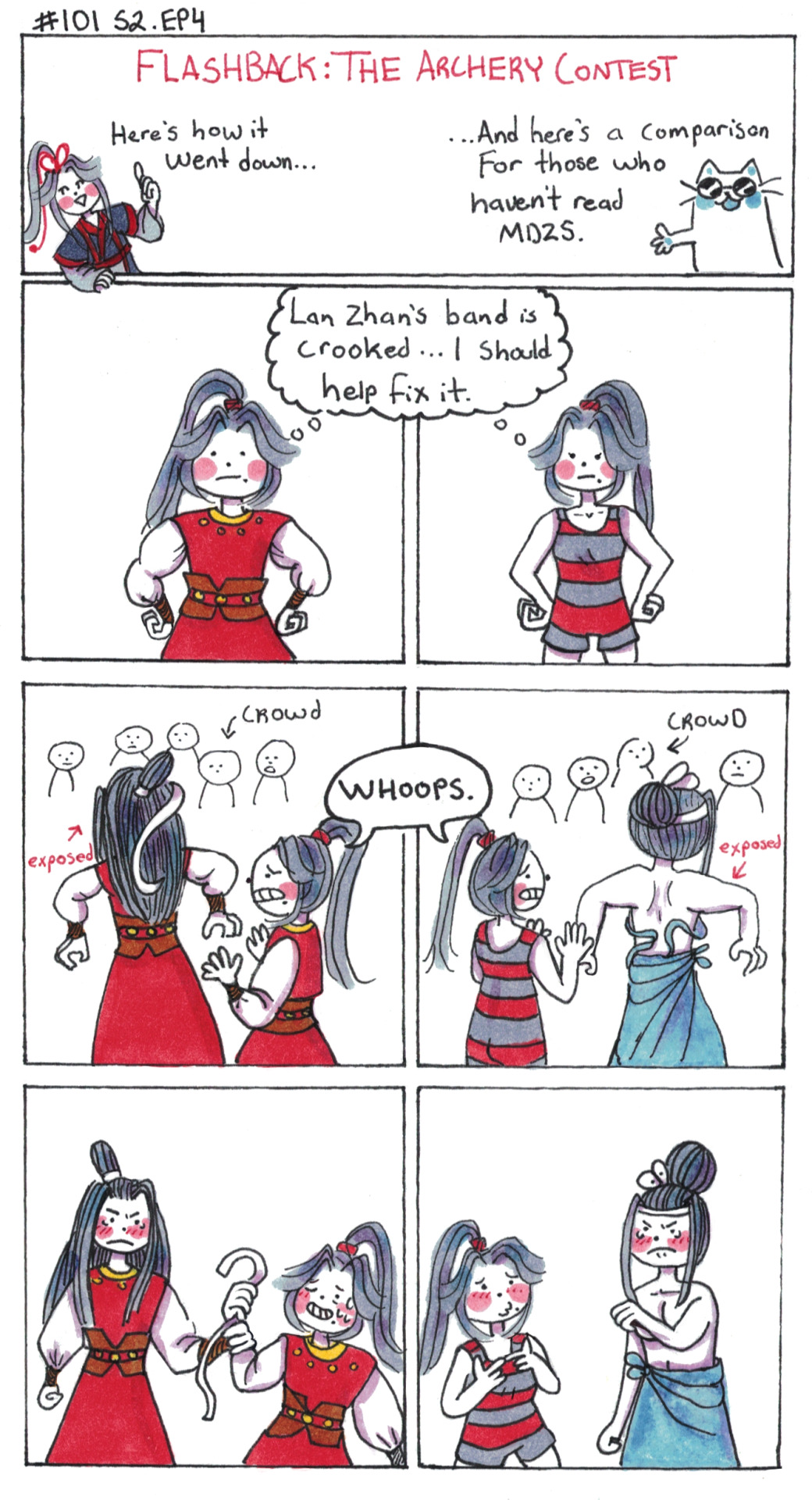
Wardrobe Woes
[First] Prev <–-> Next
#poorly drawn mdzs#mdzs#wei wuxian#lan wangji#Yes: there are people who read these comics who don't know much about mdzs. Several are my beloved and supportive friends B'*)#This comic in particular is one that I've been thinking about for a very long time and I'm so happy to finally be here!#I was trying to think about how to explain the social rules of the forehead ribbon and the reason lwj was so upset#and the metaphor of 'it's kind of like wwx accidently undoing lwj's bikini in front of a crowd.' came to mind.#of course there's a bit more to it than that but the point here is that - accident or not - it still embarrasses lwj#wwx doesn't get the entire context behind it (at the time. Now he *does* and it all makes a bit more sense)#But he knows he made lwj upset. He knows he doesn't want to put lwj in another embarrassing situation.#Not after all this. Not after everything. Not after realizing that his desire for friendship might be the kind of desire that ruins lan zha#Love the symbolism of the archery outfits being red during this moment of 'whoops only married couples can do that' moment.#What if we accidental proposed............accidental marriage....accidental kiss the bridegroom....accidental fall in love.#Guess we did inadvertently get the puffy sleeves and bikini outfits in the end.#wwx in an old timey bathing suit is so important to me. I'll die on this hill.#lwj's cute little box is inspired by @lazycranberrydoodles's cute fan art <3 I love it a lot
890 notes
·
View notes
Text
Waiting for God is like... You're expecting a guest. You haven't seen them in ages. You know they're coming, although you forget the exact time. And you don't need to impress them—they'd probably sleep on the floor, but why wouldn't you give up your bed? And it's not clean enough and you don't have matching curtains and they're not gonna care because they love you but you'll still probably do your best. Scrub the counter, at least. So you try to stay up to greet them but they're late or you were wrong about the day and you keep dozing off. All you really have to do is be at home when they knock and you'll wake up and figure everything out when they get here—but who wants to answer the door half-asleep? And you can probably get a few more things done while you're waiting. You can light a candle—that's welcoming, right?
So maybe you stay up doing dishes or maybe you give up and go to bed, but the knock makes you jump either way. It's light outside when you let them in, and that's not right, it can't be morning already. The windows are dark. Anyway, you're pouring them tea and apologizing for the mess and you realize they're not a guest at all—they live here, actually. Have your whole life. They probably make your lunch every day. Your house isn't yours at all, now that they're here, now that they've arrived and always been here. It's been yours, plural, yours together, and isn't it lovely that you don't have to worry about the curtains matching anymore? They've already seen them and chosen to stay every time.
There's another knock at the door. They arrive and you pour them tea. You get some sleep. You stop being surprised when your lunch is ready to go. You're expecting a guest. They make themselves at home; they are at home; they've been making themselves a home.
Your days are spent opening the door. They've been gone for so long; how could they have left you; why are they always forgetting to use a coaster and leaving icy circles on the wooden table; why can't you have any privacy in this house; you can't find them anywhere; this is only home when they're here; they keep arriving and you keep making tea do you think they'll ever get tired of tea do you they'll get tired of you opening the door half asleep do you think they're secretly annoyed by the mismatched curtains
Someone knocks on the door. You are interrupted. You keep forgetting you're expecting a guest. You were hoping they'd come and interrupt you. Someone knocks on the door. You're awake. You always make enough tea for two.
Eventually someone doesn't knock on your door. You find them on your doorstep waiting. You've been expecting a guest. The windows of your house are open all the time now, even though it's dark and cold, and you make your home some tea. It's never cold inside, as if opening the door let in warm air instead of cool. The candle you lit has been burning without getting smaller. You can't remember why you used to be surprised, why waiting was frantic. You wash the dishes because that's the next thing to do; because you wash the teacup of your not-guest like it's the chalice of a king.
One day you don't have a door anymore. You can see through the walls of your house and the whole galaxy spreads out before you. They're expecting a guest. You walk outside. The universe makes you tea.
#what if the bridegroom arrives but you're already married to him!#alternative title: unedited time loop jesus#Average Advent Enjoyer#come lord jesus be our guest and let thy gifts to us be blessed!!#no i haven't slept why do you ask
643 notes
·
View notes
Photo
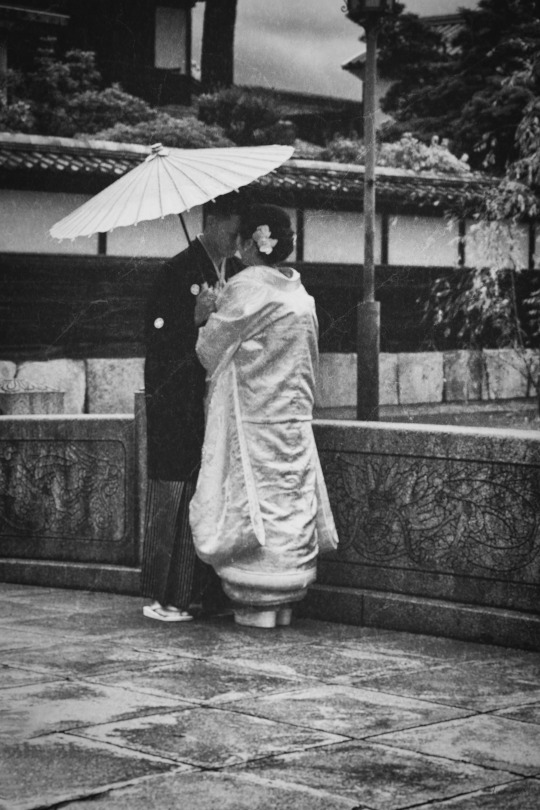
Jumy-M
Wedding Day / 門出
347 notes
·
View notes
Photo

Ninth house by Leigh Bardugo
Now that Tumblr is chill I can post this
140 notes
·
View notes
Text
you're telling me that THEE BRIDEGROOM isn't coming back!?! Leigh, ma'am, that is my emotional support ghost.
19 notes
·
View notes
Text




#g-witch#the witch from mercury#suletta mercury#miorine rembran#mioletta#sulemio#i had given up on finishing this#but they dropped the S2 trailer and i went AAAAAAAA#thinking this up after S1 finale i forgot she has duel obligations#in this comic. she hangs around the hospital building like a sad puppy#mio keep avoiding her and making excuses so she just lingers#she has other clothes but shes unsure if theyre appropriate#there arent many civilians to get a good idea#but allssooo its so exert d- i mean show that shes still set on being her bridegroom#at any rate it made it super easy for miorine to spot her#a little dance 💃 n collaspes into bed 🛌
441 notes
·
View notes
Text










Ninh Bình. Credit to Kiến’s Collection.
#vietnam#vietnamese#culture#history#sinosphere#fashion#travel destinations#travel#ninh binh#wedding photoshoot#bride#bridegroom#wedding dress#couple#couple photography#couple photoshoot#traditional architecture#asian architecture#mountains#rivers#lotus pond#lotus flower#boats#farmers#rural landscape#rural aesthetic#rural#rural life#ruralcore#rural photography
106 notes
·
View notes
Text
Update delay
There won't be an update of Death sent the bridegroom this week, sorry! I'm traveling for a conference and will be too busy to manage it.
66 notes
·
View notes
Text
Some scholarly notes about the Grimm fairytales (1)
Recently in France (well... for the last two dozen years), the publishing house José Corti has been specializing itself in scientific fairytales collections. While for the study of literary fairytales one would go towards Honoré Champion, when it comes to folktales and fairytales it is José Corti one must check. In their "Merveilleux" collection they have been publishing for the very first time in France or republishing out-of-prints collections of various European fairytales (from Denmark, Spain, Romania, and more) - with a few classics of the "literary" fairytales that marked deeply the evolution of the genre (such as Straparola's Facetious Nights or Ludwig Bechstein's fairytales).
All of that to say, José Corti has in 2009 published the most recent scientific (but for an all-public) edition of the brothers Grimm fairytales. The full collection of their fairytales, translated accurately in French, with annotations about their type/classification, their evolution throughout editions and their predecessors. I can't share all of these annotations with you, of course, but I can share a handful of them, about the most famous stories of the Grimm. They all come from the same person who translated the story in this edition: Natacha Rimasson-Fertin. (Of course my notes might be incomplete but hey, you'll have to buy the books to see the whole thing :p Or check them out at your local library)

The devil with three golden hairs (Der Teufel mit den dre goldenen Haaren)
This story is at the crossroa between the Aa-Th 461 "Three hair from the devil's beard" ; the AT 460B "The quest for fortune" and the AT 93à "Urie's letter/The prophecy".
In the 1812 edition, there were two different versions of this tale. Story number 29 "The story of the devil with three golden hair", told by Amalia Hassenpflug, and number 75, "The phenix", told by her sister Mary. In the second version the devil was replaced by a phoenix, and the hero had to get three feathers. In the 1819 edition the two stories disappeared and were replaced by the version we know today, told by Dorothea Viehmann. Another version that the Grimms had collected in 1812 had a princess falling in love with the woodsman that cuts a tree below her window.
The final episode, where the hero asks three questions to the devil through the old woman, echoes the Pentamerone's "The Seven Doves". Other versions of this story include Asbjörnsen-Moe's "The wealthy Peter Krämer", and Afanassiev's "Marco the Wealthy and Vassili the Unfortunate". The story of the brothers Grimm gathers several references to the Bible: the child throw in the water echoes Moses' abandonment, the letter meant to kill the hero is similar to the one David uses to kill Urie, finally the hair as holders of a being's wisdom and strength is linked to the legend of Samson and Dalila. But many other elements of the story evoke older faiths. The idea of a body of water as the frontier with the Otherworld can be found in the Classical Antiquity with the Greek Charon, and is found in other stories of the volume, such as "Frau Holle" and "The Iron Stove" - it as believed that water formed an obstacle spirits could not cross. The hero's mission recalls a tale of Saxo Grammaticus where Thorkill enters Utgard (the realm of supernatural beings) to steal a hair from the beard of Utgard-loki. The brothers Grimm had noted that the belief in the exceptional fate of a child born with a "hood" was also found in Iceland, where the "caul", called Glückshaut (skin of luck) was the home of a genie that would follow the child all of his life. And indeed, modern research has proven that the name given to this caul, the "fyljia" was also the name of a spiritual double, a tutlar spirit tied to a person or a family. This is why the tradition was to preserve and hide this "pileus naturalis" - in Belgium, it was called a "hem" and its color allowed for divination rituals about the child's future.
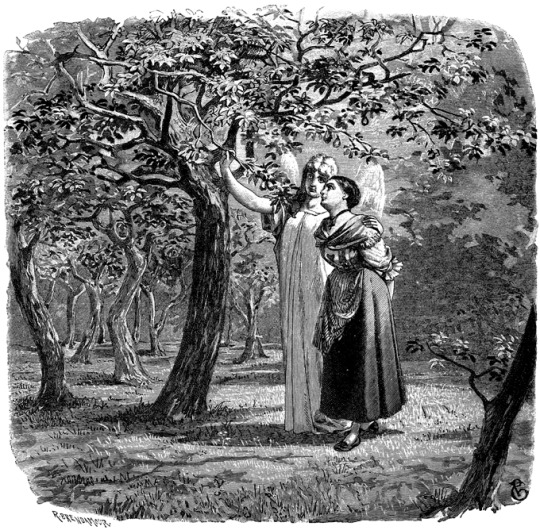
The girl without hands (Das Mädchen ohne Hände)
This fairytale is actually a cross between the AT type 706 "The maiden without hands" and the AT 930 "Urie's letter/The prophecy". The story was created by the brothers mixing two versions from Hesse, one told by Mary Hassenpflug, the other by Dorothea Viehmann. The second version lacks this story's introduction and begins with a father trying to marry his own daughter - when she refuses, he cuts off her hands and breasts, and chases her out of his house. It then follows the story. Meanwhile, the first version differs when the heroine is with her child in the forest: an old man tells her to hug three time a tree with her arms, which makes her hands grow again. He also tells her to only open the door of her house to one who will ask to enter "for the love of God" three times in a row - the king will be forced to do this before entering.
Outside of these two main versions, the brothers Grimm collected three additional ones. In the first, the angel that guides the girl is replaced by a small light that descends from the sky ; and the hands of the girl grow back when she plunges her arms in a stream after seeing a blind mouse enter its water to regain its sight. In the second version, a man is upset at his little girl praying for him day and night, but since she refuses to stop despite his demands, he cuts off her tongue. But she prays in thought and makes the sign of the cross, so he cuts off her right hand, then her arm all the way to the elbow, before banishing her. She is saved by a hunter that hides her in his master's domain and feeds her in secret with his master's dogs. When the master discovers this, he decides to raise the girl as his own child. One day she gives money to a poor man, who tells her she will regain her arm and tongue if she goes to drink of a certain stream, and he gives her a magical staff to protect her. When she returns at the lord's house, he marries her. The third version is about a queen banished by her husband with her two children, and is identical to the legend of saint Helen.
Other international versions of the tale include Zingerle's "The pretty daughter of the innkeeper", Basile's "Penta the one-armed girl" and Afanassiev's "The young girl without hands". There are some versions where it is a man that is mutlated, such as Afanassiev's "The brave without legs and the blind brave". The roots of this story date back to the end of the 12th century, and are located in southern England - this tale was the subject of numerous literary adaptations, the most famous being the verse romance of the 13th century "The Beautiful Helen of Constantinople".
The motif of the child sold to the devil is recurring among the Grimm fairytales - even though the character of the devil can be replaced by another supernatural being, such as in "Rapunzel" or "The Nixie of the Mill-Pond". The idea of offering the first thing one sees upon returning home is as old as the Ancient Testament (Judges). This story bears the signs of a heavy Christianiation, and was clearly inspired by the legend of Saint Genevieve of Brabant, falsefely accused of being unfaithful and condemned to death with her newborn child. The executioners take pity on her and she lives alone in the woods for seven years. As with other tales from the Grimm collection, this story mixes the Christian fantasy (the hands that regrow are treated as a Christian miracle) with pagan fantasy (there are several elements of folk-magic, such as the circle the girl draws around her to be protected from the devil, or the accusations of the queen giving birth to a changeling - a changeling also appears in the third story of "The Elves", KHM 39).

The Robber Bridegroom (Der Räuberbräutigam)
This story belongs to the fairytale type Aa-Th 955, named after it: "The robber bridegroom".
The tale was told to Jacob Grimm by Mary Hassenpflug, and was present as early as the 1810 manuscript. However this first version, that the brothers deemed "incomplete" was replaced from the 1812 edition onward by a new version which mixed two versions from Lower-Hesse. The brothers noted the existence of another version where the robber indicated the road to his house to a princess, by tying ribbons around the trees.
Ludwig Bechstein took inspiration from the brothers Grimm's tale to create his own "The Robber Bridegroom". This fairytale, like "Fichter's Bird", belongs to the "Bluebeard cycle" (several tales that the brothers removed from their first edition also belonged to this cycle).
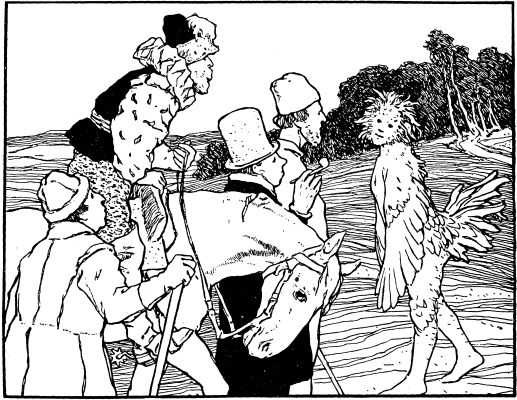
Fitcher's Bird (Fitchers Vogel)
This tale is a variation of the Aa-Th 311 "The heroine rescues herself and her sisters", usually classified under the "Bluebeard" category.
The final text of the Grimms is actually a mix of two different versions of the same story that was told to the brothers by both Friedrike Mannel and Dortchen Wild. The Grimms noted the existence of a version from Hanovre which goes as follow: a poor woodcutter asks his daughter to bring him his meal in the forest, and to show them the way he places peas on the floor. However dwarves notice this, and change the emplacement of the pea so that their path leads to their grotto. The older girl follows the peas, and become the dwarves' slave. Then we have the Bluebeard "forbidden room" motif, and the story goes as the "Fitcher's Bird" goes, as the dwarves lure the two other sisters to their cave. The last sister sticks the feathers on her body by rolling herself in blood (presumably the blood of the dwarves' victims), and there is no resurrection of the sisters. Everybody that meets her on the way call her "geputzter Vogel". The dwarves hunt the girl down and almost catch her just as she reaches her father's house - she is so fast in closing the door that it cuts a piece of her heel. The Grimms also knew of a Dutch version of the story, translated in German, and that was identical to one of their first-editions tales, "The Murder-Castle".
The translation of the name of the "bird" always caused many problems, due to the difficulty of understanding the expression. The brothers Grimm themselves explained the name of the bird by the Icelandic "Fitfuglar", meaning "birds that swim" - as such, the girl would be called "Fitchers-Vogel" because she looks like a swan". However, other people do not agree with this etymology, some linking Fitcher with "Fitze", the thread. Rimasson-Fertin highlights that the expression "Fitchers Fitze", outside of a simple sonority game, might be two variations of the male name Fritz (the diminutive of Friedrich) - other usual diminutives were Fitze, Fitz and Fiete. The brothers Grimm noted that the motif of the blood that cannot be erased was much older than Perrault's Bluebeard - it could be found as early as the "Gesta Romanorum", where a mother who had murdered her child couldn't erase three blood-drops from her hand, forcing her to wear a glove. This story must be compared to the KHM 40, "The Robber Bridegroom".

The Juniper Tree (Von dem Machandelboom)
It is the AaTh 720 "My mother killed me, my father ate me".
Just like the tale of "The Fisherman and his wife", this story was written by the painter P. O. Runge, and the brothers Grimm used it as a model for how they should present their own fairy tales. In fact, we can note sentences almost identical between the two tales.
The brothers noted a variation of the story where the stepmother places her daughter near the pot where her brother cooks, and she forbids her from looking inside. But since the pot boils too much, the girl lifts the lid - then her brother's hand reaches out to her from the cauldron. There is yet another version noted by the Grimm where there are three children, not two, and the stepmother sends them pick up strawberries in the wood, promising an apple to whoever comes back first.
The cruelty of this fairytale earned the brothers a serious criticism from Achim von Arnim - who only tolerated such violence because it echoed the one present in Goethe's Faust. The description "red as blood, white as snow" of course echoes the tale of "Snow-White". The brothers Grimm mentionned in their notes that the juniper tree was a plant believed to have the power to bring back youth - and Rölleke noted that the juniper-tree's red berries were used in folk-magic. It seems to be a very ancient tale due to several very old motifs such as the soul returning in the shape of a bird, a resurrection out of bones, and cannibalism. This tale must be compared to "Brother Lustig", "The Singing Bone" and, of course, "The Fisherman and his wife".

Briar Rose (Dornröschen)
Of course, it is the AaTh 410 "Sleeping Beauty".
This fairytale was present as early as the 1810 manuscript, written by Jacob Grimm from a tale told by Marie Hassenpflug. Research has proven that this story is derived from Charles Perrault's own Sleeping Beauty. We also find back in the German story a motif coming from another famous French literary fairytale, madame d'Aulnoy's "The Hind in the Woods/The Doe in the Woods" (also known as the White Doe). In this story a Crayfish/Lobster fairy announces to the queen she will have a child, and later the same fairy curses the princess as she is born - and what a coincidence! In the first edition of "Briar Rose", the animal that announces the princess' birth is not a frog... but a crayfish. Proving that there is a direct link. As for the name of the princess n German, "Dornröschen", "small briar rose", it actually first appeared in the German translation of a 1730 fairytale by Anthony Hamilton (an Irish man who however spoke and wrote French), "Fleur d'épine" (Thorn flower/Briar flower) - it had been translated in 1790. Bolte and Polivka have also noted a comedy by Gryphius from 1660 whch was named "Die geliebte Dornrose", "The beloved briar rose".
In their notes about the fairytale, the Grimm brothers explicitely compare Briar Rose to the legend of Brunhild asleep behind a wall of fire, cursed into a magical slumber by Odin's "sleep-thorn" and woken up by Sigurd, the only one able to cross the wall of flames. The brothers Grimm were also aware of Basile's version of the story, "Thalia, Sun and Moon", which they compared to their own Briar Rose in their notes. The brothers were very fascinated by the consistant naming of the princess' children from Perrault (Dawn, Day) to Basile (Sun, Moon) and compared it to the occurences of "Day, Sun and Moon" as names within the Eddas. However we know that Perrault was heavily inspired by Basile's story when writing his own Sleeping Beauty, and only modified some parts so as to erase the more shocking and "unpleasant" parts (such as the married prince having sex with the sleeping girl). Of course, this story is also to be compared with the 14th century medieval tale of the Roman de Perceforest.
The wise women that appear in this story are the Germanic equivalent of the fairies. In fact, we know that the brothers Grimm carefully avoided (or erased) any mention of "Fee" (the German word for the English "fairy" and French "fée") from their tales, so as to better differentiate them from the French "fairy tales", "contes de fées". By turning the fairies into wise women making predictions at the child's birth, the Grimms notably opened an entire set of symbolism and interpretations linking them to the mythological figures of the Norns, Parcae and Moirai.
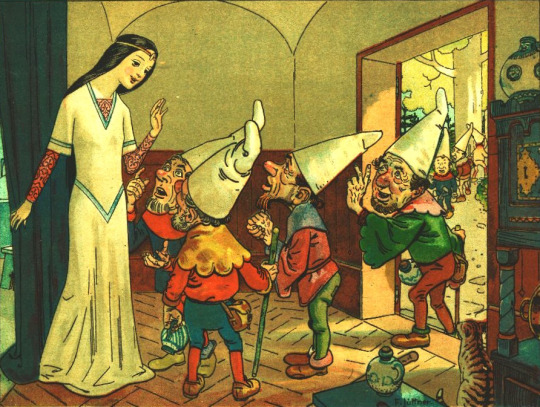
Snow White (Schneewittchen)
Of course, it is the AaTh 709 "Snow-White".
The full editing history of this tale was only "recently" recreated (the book was published in 2009, it was recent back then) in its entirety. We know that it begins in 1808 with a version collected by Ferdinand Grimm, brother of Jacob and Wilhelm, called "Schneeweibchen". It seems Ferdinand might have invented the story on his own. Wilhelm and Jacob then slowly modified it, by adding details from other collected versions, before publishing it in their first edition in 1810 (they did note at the time that it was a Lower-Germany story, and that in Upper-Germany the tale did exist but with the deformed name of "Schliwitchen". When the Grimms did their second edition, the main change they performed onto this story was the modification of the wicked mother into a wicked stepmother - something they also did for "Hansel and Gretel". In fact, from edition to edition the Grimms kept adding adjectives and expressons highlighting the opposition between the girl and the vain queen.
Th Grimms had collected several variations of the tale. One was much closer to the tale of "The Juniper Tree" and in it the queen, as she was with the king on a hunting sled, cut her finger while peeling an apple. In another variation the king and queen were walking by three mounts of snow, than went by three pools of blood, and finally saw three ravens in the sky, and each time the king wishes for a girl with the corresponding colors - soon afterward the couple encountered a little girl fitting this description. The king, immediately attached to her, takes her with him in their royal carriage, but the queen immediately hates her and tries to get rid of her - so she asks the girl to go seek a glove she threw out of the window, and while she is out of the carriage she asks the driver to leave as fast as he can. Then the little girl takes refuge at the seven dwarves' house.
The fairytale existed in German literature before the brothers Grimm published it. Indeed J. A. Musaüs had published in 1782 a fairytale called "Richilde" - and the Grimm were influenced by this tale, since in the margins of their first edition, they noted about Snow-White "It is Musaüs' Richilde". There was also a Snow-White story that had been published in 1809 in a fairytale book by A. L. Grimm (no relationship to the brothers Grimm). The Brothers Grimm did note the striking similarity between this story and the Norse pseudo-historical legend of Snäsridr, the beautiful wife of "Harald with fair hair", a wife that, when she died, stayed in her prime state so that it seemed she was still alive.
This fairy-tale has a very wide area of spreading, as it can be found from Ireland to Turkey passing by central Africa. It is especially present in the literary Italian compilations of fairytales. Basile has three variations of the story in his Pentamerone: "The raven", "Nennillo and Nennella" as well as "The she-cook".
The various virtues that Snow-White shows in this tale made her one of the big role models within the education of bourgeoisie girls in the 19th century - alongside Cinderella, of course. In fact, according to H-J Uther's analysis of the story, it is because of all her virtues that Snow-White's beauty does not fade away and stays undamaged even in death, unlike her wicked stepmother whose vices causes the fading of her charms. Finally, this fairytale is actually the proof that the brothers Grimm did not simply listed their fairytales one after the other in a random order, but deliberately created "bridges" and internal references to create a cohesive world within their book. Indeed, the mention of the snowflakes looking like feathers references "Frau Holle", while the glass coffin can be found back in, of course, "The Glass Coffin", and the blood-drops on the snow evokes "The Juniper Tree".
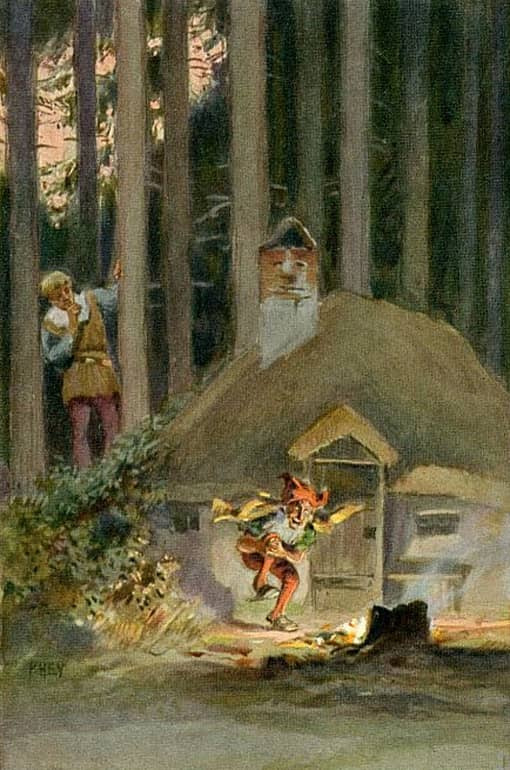
Rumpelstilzchen
Yes this story is the famous "Rumpelstilskin" (or Rumpelstiltskin? I never know how to write it in English). But why keep the German spelling? Because Rimasson-Fertin has some stuff to say about it: this name is the diminutive form of "Rumpelstilz", a term that Jacob Grimm defined in his "German Dictionary" as being synonymous with "poltergeist" (he noted a similarity between Poltergeist and Rumpelgeist, both designated a very loud spirit). While today "poltergeist" is mostly associated with ghosts, in a much broader way it designate a dwarf, a dead or a devil - or just any kind of phenomenon caused by witchcraft.
This story corresponds to the AaTh 500 "The name of the supernatural being". This fairytale has an interesting evolution history... Jacob Grimm had a version of it as early as 1808, named "Rumpenstünzchen", which was then slightly modified for the 1810 manuscript. This tale was actually the mix of two different versions - and one of these versions had a different ending. The queen didn't sent messengers searching for the dwarf's name, rather the king spotted the little man while returning from hunting on the third day. The Grimm also noted a variation where the initial situation was reversed: a young girl who had to spin hemp but could only manage to spin gold much to everybody's despair, and a small man appeared to promise her a wedding to a king's son in exchange for her firstborn child. It ended in such a way: the queen herself spotted the small man singing his name, jumping around a fire while riding a ladle like a horse. When she guessed his name, he flew out of the window and into the sky, riding the ladle like a witch's broom. We know that the episode of the spinning of the straw was only added by the Grimm in 1812 (it is not in the 1810 version), and that the final scene of the dwarf self-mutilating comes from a story of Lisette Wild and was added in 1819.
The first literary record of this story is a French fairytale published in 1705 and written by Mlle Marie-Jeanne L'Héritier de Villandon. It was "L'Histoire de Ricdin-Ricdon" (The Tale of Ricdin-Ricdon), published in her "La Tour ténébreuse et les jours lumineux" (The Shadowy tower and the luminous days). It had been translated in German by Johann Gottwert Müller in 1790, under the title "Straubfedern", "Ostrich feathers". As for the name "Rumpelstilzchen", it actually originates from Johann Fischart's Grman adaptation of the French "Gargantua", "Geschichtklitterung" (1584) - in it, Fischart lists various children game by name, and mentions a "Rumpele stilt oder der Poppart".
This fairytale type is very present in Western, Central and Northern Europe (British Isles and Ireland included), with also a few spottings in the Baltic countries, China and Japan. The name of the supernatural being always changes from one region or country to the next (in Swiss it is Hans-Öfeli, in Dutch Trillevip, in Swedish Titteliture, in Finnish Tuttirituli, in the Suffolk it is Tom Tit Tot, in Welsh Gnarwynathrot, in Irish it is Eve-Trot or Trit-a-Trot...). It is part of the enormous success of this tale-type: every country has to invent its own brand of nonsensical, un-guessable name. As for the rhymed song through which the dwarf betrays its name, it is found in England as "Nimmy nimmy not / My name is Tom Tit Tot", and in an Afro-American version of North Carolina "I'm so glad that she do not know / That my name is Tabutoe Tambutoe".
The brothers Grimm noted that in Germanic mythology it was typical for underground beings (aka dwarfs) to have names that are not usual among humankind, which is why, again according to them, the dwarf of this story would feel in perfect safety proposing the queen such a game. The rule according to which obtaining the name of a supernatural being means gaining a form of power over them is very common, and is even reused in another one of the Grimm stories: KHM 136, "Iron John". H. Rölleke did an analysis of the names the queen proposes at first: we have the three names of the Magi, aka the Three Wise Men, or King-Magi, which gives a Christian setting to the story, and could also serve as a metonymy for all the saint names found in the Christian calendar. As for "Heinz" and "Kunz", Rölleke sees in them the diminutives of the names of the medieval emperors Heinrich and Konrad, which used to be some of the most popular male names among German-speaking countries.

All-Kinds-of-Fur (Allerleirauh)
It corresponds to the AaTh 510B "The dresses of gold, silver and stars", also known as "Donkey Skin", after the famous Charles Perrault fairytales.
The story we read today was the one told to the Grimm by Dortchen Wild, but there was a variation of it told to the brothers by Jeannette Hassenpflug, "Princess Mouse-Skin", which was present in the 1812's edition of the volume (n°71) but was then moves to the annotations as a mere mention. The version of the story from the first draft (the 1810 manuscript) was called "Allerlei Rauch", "All Kinds of Smoke", and was heavily inspired by one of the tales present within the novel "Schilly" by Carl Nehrlich.
The line "God forbade a father from marrying his daughter. Nothing good can come from this sin which will cause the kingdom's decadence" was added in the 1819 edition, and references a tale of Albert Ludwig Grimm called "Brunnenhold und Brunnenstark". The brothers Grimm insisted even more on the condamnation of the sin of incest when rewriting the story for their "small collection" for kids, and also insisted heavily upon a political extension of such a decision, which would damage the state itself. It is actually an allussion to the failure of the Frankfort Parliament, which had been gathered in 1848 at the Paulskirche in an attempt to create a constitution for all of Germany - to which Jacob Grimm had taken part.
A variation of the story collected in Paderborn has the last coat made of all the furs of the kingdom, plus moss and various forest-related material. In this version, the heroine puts the cloak on top of her three beautiful dresses before fleeing, and she hides in an empty tree where she is discovered, not during a hunting party, but by woodsman that cut off the tree she was sleeping into, to bring wood to the king. All-Kinds-of-Fur works in the castle's kitchen but one day as she is preparing the soup, the king has her sit on his chair so she can delouse him (a motif also present in "The Devil with Three Golden Hair). As she does, the king glimpses the beautiful shining dress under the cloak's sleeve, and this is how he discovers the girl's true appearance. Another variation of the story yet, also collected in Paderborn, has the heroine pretending to be mute. One day the king hits her with a whip, it rips apart the coat, revealing the golden dress underneath.
Not all the German versions of the story include the incest motif. In Musaüs' take on the story, "Die Nymphe des Brunnens", "The Nymph of the Well", the heroine leaves her father's castle because it has been destroyed. Her godmother, an undine, gifts her a small magical box and when she leaves the ball she says "Night behind me and day before me / Might nobody see me!". As for the version of Hassenpflug, "Princess Mouse-Skin", it begins as the KHM 179, "The Goose-Girl at the Well": a king wants to know which of his three daughters love him the most, the first says she loves him more than the whole kingdom, the second more than pearls and precious stones, the third more than salt. The furious father has the last princess be sent into the woods to be killed, but the servant tasked with the execution spares her out of pity, and gives her, by her request, a coat made of mice skin. The rest of the story goes like within "All-Kinds-of-Fur", except for the final wedding, to which the father-king is invited. All the dishes served to him are without salt, and he ends up saying he prefers to die rather than continue eating without salt. The princess-daughter reveals herself and points out how he tried to had her killed for loving him more than salt. Her father begs her for forgiveness, and the tale ends with her accepting.
The motif of the incest can, however, be found back in a variation of the KHM 31 (The Girl Without Hands) that the Grimms collected, and where the father mutilates the daughter for refusing to marry him. The motif of the king trying to marry his own daughter has been attested in many, many European stories ever since the 12th century. As for the boots that are thrown in the heroine's face in the Grimm story, while in the final edition it has no follow-up, in the 1812 edition it was a recurring element forming a motif within the tale. Another German version of the story that preserved this structure that the Grimms erased is the story collected by Vernaleken, "Throw-Broom, Throw-Brush and Throw-Comb". In it the king throws out of anger at the face of the heroine (Adelaide) a broom, a brush and a comb. Every time she goes to the ball, she changes her pseudonym to fit which item hit her (one night she is "Throw-Broom", another she is "Throw-Brush", etc...). There are many, many variations of the story containing such a "name play".
Other famous examples of this variation, outside of Charles Perrault's Donkeyskin, include Straparola's "The maiden in the chest", Basile's "The She-Bear", Afanassiev's "Pig-Skin".
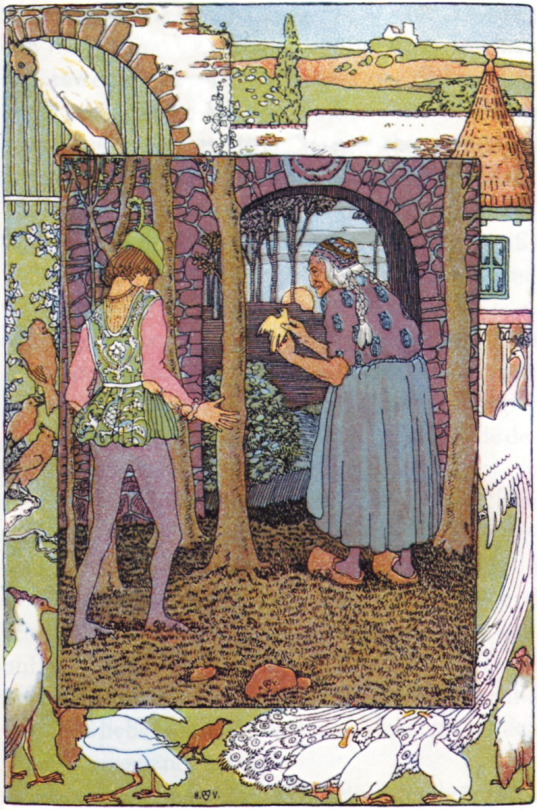
Jorinde and Joringel (Jorinde und Joringel)
It corresponds to the AaTH 405, named and created after this story, "Jorinde and Joringel".
The interesting thing with this story is that the brothers Grimm did not collect it from a direct source. Rather they lifted it, to the exact word, from the autobiography of Johann Heinrich Jung, "Jugend/Youth", published in 1779. The brothers deemed that the way Jung-Stilling had written the tale was the "perfect" way to tell the story, according to their definition of a fairytale. Though they did note the existence of a version of the story told in Schwalm - but which differs very little from the story of Jung-Stilling.
The brothers Grimm themselves noted a similarity between this story, and the KHM 123, "The Old Woman in the Wood". Rimasson-Fertin notes that the witch in this story is to be compared to the ones appearing in "Hansel and Gretel" and in "Little Brother and Little Sister". As for the name of the demon the witch invokes, "Zachiel", H. Rölleke identified it as a form of "Zachariel", a demon name coming from the very popular 17th century demonology grimoire "Clavicula Salomonis", "The Clavicles of Salomon".
#brothers grimm#grimm fairytales#brothers grimm fairytales#german fairytales#sleeping beauty#briar rose#snow-white#snow white#jorinde and joringel#all kinds of fur#the juniper tree#the devil with three golden hair#the three golden hair of the devil#the robber bridegroom#the maiden without hands#the girl without hands
21 notes
·
View notes